Porcelain veneer – the secret of the perfect smiles of celebrities 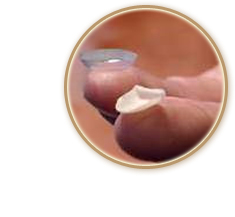 The most elegant achievement of aesthetic dentistry is providing the perfect smile with teeth of desired whiteness and beauty. For this result there is no need to polish the whole tooth, only 0.5-1 mm is removed from the visible, front surface of the tooth to make place for a very thin, shell like, fixable ceramic layer which is individually prepared by the technician on the basis of an impression. As a result of this the tooth looks much more aesthetic, practically the desired colour shade can be reached without the need to make a crown. The most elegant achievement of aesthetic dentistry is providing the perfect smile with teeth of desired whiteness and beauty. For this result there is no need to polish the whole tooth, only 0.5-1 mm is removed from the visible, front surface of the tooth to make place for a very thin, shell like, fixable ceramic layer which is individually prepared by the technician on the basis of an impression. As a result of this the tooth looks much more aesthetic, practically the desired colour shade can be reached without the need to make a crown.
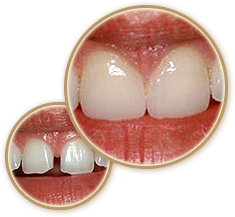 The application of ceramic veneers combines the advantages of delicacy and the removal of only minimal tooth material with the aesthetic harmony of restoration. The application of ceramic veneers combines the advantages of delicacy and the removal of only minimal tooth material with the aesthetic harmony of restoration.
Areas of application: - enamel defects, decays and discolouring in the tooth material
- traumas: the breaking of teeth’s tips
- the cracking of teeth’s tips
- colour correction of discoloured, root-treated teeth
- harmonically aligning teeth that are protruding or bent inward
- diminishing, closing fissures, gaps between teeth
- correcting the axis of misaligned teeth without orthodontics
Direct veneer is a special veneer made entirely by the dentist out of special filling materials with the help of a special layering technique. The greatest advantage of direct veneer is that only minimal own tooth material has to be sacrificed. It is better than ceramic veneer because these restorations are executed in the course of one sitting, if necessary, more teeth can be treated at a time. Direct veneers are less vulnerable than ceramic veneers and may be quickly corrected at any time (in both colour and form), and since they do not need a technical laboratory background, they are less expensive.
Crowns 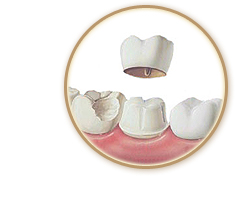 In case a significant part of the tooth material has been affected by decay, it is no longer possible to fill the tooth. While it is possible to put a filling or a replacement into a tooth with smaller decay, in case of the decay affecting a great part or the four surfaces of the tooth this needs further consideration. In these cases the risk of the tooth’s breaking is great. In order to prevent breaking and secondary decay it is best to put a crown on the tooth. With the help of an artificial tooth crown the remaining tooth can be preserved and rebuilt. In case a significant part of the tooth material has been affected by decay, it is no longer possible to fill the tooth. While it is possible to put a filling or a replacement into a tooth with smaller decay, in case of the decay affecting a great part or the four surfaces of the tooth this needs further consideration. In these cases the risk of the tooth’s breaking is great. In order to prevent breaking and secondary decay it is best to put a crown on the tooth. With the help of an artificial tooth crown the remaining tooth can be preserved and rebuilt.
Crowns are made of different materials: - zirconium-oxide ceramic crown
The metal-ceramic process is the most widespread, where the ceramic is burnt onto the metal frame. The metal ensures the employment of the crown, while the concealing material provides the aesthetic effect. The great advantage of ceramic concealment is that a very strong chemical bond develops between the ceramic and metal parts. At the same time there are entirely metal-free crowns, bridges: 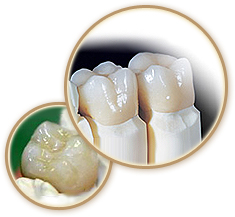 zirconium-oxide crowns zirconium-oxide crowns It is important to make sure already at the time of planning the tooth replacements whether the patient is suffering from any type of allergy, since this happens ever more frequently. We cannot cease to emphasize that it is practical to conduct allergy tests in case of the slightest suspicion or before bigger replacements, since this way numerous inconveniences and extra costs can be avoided. Allergic reactions are most frequent in case of metal-ceramic crowns, while they are significantly more rarely present in case of titan crowns; and in case of gold, zirconium-oxide and full porcelain, these type of complaints are almost never present.
Bridges
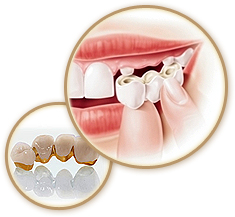 If we have lost our teeth for some reason a replacement is needed for proper chewing function and aesthetic effect. In most cases the extracted tooth needs to be replaced. The prosthesis restores the original chewing ability, sound production and naturally restores the aesthetic harmony of the face as well. The missing of only one tooth already changes the masticator organ’s function and aesthetics as a unit. With a good tooth replacement masticator joint complaints and aesthetic problems can be prevented. If we have lost our teeth for some reason a replacement is needed for proper chewing function and aesthetic effect. In most cases the extracted tooth needs to be replaced. The prosthesis restores the original chewing ability, sound production and naturally restores the aesthetic harmony of the face as well. The missing of only one tooth already changes the masticator organ’s function and aesthetics as a unit. With a good tooth replacement masticator joint complaints and aesthetic problems can be prevented.
Unfortunately it is not possible to save every tooth. If we choose a bridge to replace a missing tooth then the adjacent teeth have to be prepared. We make a crown for the two teeth adjacent to the missing one(s) and by making the replacement teeth together with these crowns the missing teeth can be replaced. This is called a bridge. This way more, up to 4 adjacent teeth can be replaced. Metal-ceramic bridges The bridge body replacing the missing teeth is fixed on the teeth adjacent to the missing one(s) with a metal-ceramic crown. The metal-ceramic bridge frame can be made of exclusively nickel-free, non-precious metal alloy and platinum gold.
Zirconium-oxide bridges
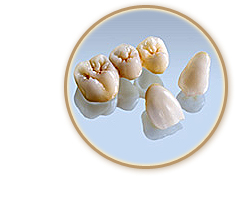 Thanks to the CAD/CAM technique, very precise bridges can be made from zirconium-oxide frames which have a similar stability to that of metal-ceramic and golden-ceramic bridges but are able to meet much higher aesthetic requirements. The zirconium-dioxide tooth replacement made with CAD/CAM technology is called the "high tech" of today’s dentistry in the field of fixed prosthesis. The aesthetic and biological advantages are entirely cost and value proportionate. It can be bravely recommended for every patient. Thanks to the CAD/CAM technique, very precise bridges can be made from zirconium-oxide frames which have a similar stability to that of metal-ceramic and golden-ceramic bridges but are able to meet much higher aesthetic requirements. The zirconium-dioxide tooth replacement made with CAD/CAM technology is called the "high tech" of today’s dentistry in the field of fixed prosthesis. The aesthetic and biological advantages are entirely cost and value proportionate. It can be bravely recommended for every patient.
Inlay bridges 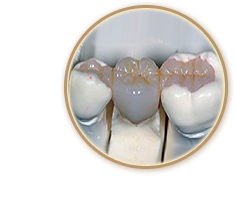 If there is any filling, inlay (filling made by a technician) in the teeth adjacent to the missing one(s), if the teeth are decayed or healthy, inlay anchored bridges can be made. If there is any filling, inlay (filling made by a technician) in the teeth adjacent to the missing one(s), if the teeth are decayed or healthy, inlay anchored bridges can be made.
The advantage of this tooth replacement is that it entails the sacrificing of only a few tooth materials, while its disadvantage is that it is not suitable for replacing greater gaps of missing teeth.
Implant anchored bridge
If there is a great lack of teeth and the remaining teeth do not hold a bridge biomechanically, the implant installed into the place where there is a lack of teeth is used as a bridge anchor. In case of a proper number of implants the lack of teeth can be used for the making of a bridge without grinding the remaining teeth. In this case the implant head screwed into the implant ensures the bracing of the bridge. The crowns are either screwed or cemented on the implant head. | 

 és Webmark
és Webmark